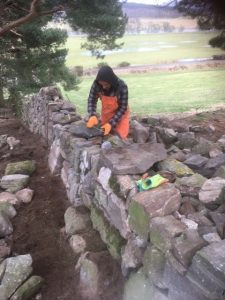The Importance of Stone Dykes
Dry stone dykes (or walls) and hedges are a common field boundary in many parts of the UK. They were originally planted or built for stock control and shelter, but they have taken on many other ‘unofficial’ functions over the centuries. Hedges in particular are well known for their wildlife value, indeed one measure of their age is the number of plant species found within them. Walls are more often found in upland Britain where the conditions can be less favourable for growing hedges and there is an abundance of stones cleared from fields. Walls are also important for wildlife offering shelter within them to many species of animals as well as a surface for lichens and mosses to grow upon. They, like hedges, also provide valuable networks across an area which allows the passage of animals and connects other habitats such as woodlands.
The similarities between the two don’t stop here however, both require skill in making them and maintaining them. Hedge laying is an ancient country skill and is still practiced. It produces a better-quality hedge than the modern mechanical cutting approach though this is much quicker and therefore less expensive to do. There is no such short cut to a wall, to maintain these takes real skills and has probably been practiced for thousands of years. As such it is time consuming and so expensive to do. This is why there are so many tumbledown walls in our landscapes; frequently replaced with a white stock fence.
The CNPA has been trialling dyke restoration on a few farms. Though the practice hardly needs a trial we are specifically looking at the value to nature. The study is looking at the process of restoration and will be maintaining a watch on how the walls are recolonised and used through standard monitoring techniques. A well-made wall will stand for more that 100 years. This is incredibly valuable as a stable and undisturbed habitat. That is quite a legacy for any conservation project. During the reconstruction of ruined walls we have already seen lizards, toads and the feeding signs from weasels – rabbit and bird skulls. There are also signs that the wall route is used by badgers in some places too. The old stones already have lichens on then and in many places they are replaced on the same orientation as before. A good repair is one which you can hardly tell it’s been done.
We have worked with three local walling contractors from Grantown, Aviemore and Aboyne to restore and repair about 800m of wall on six farms. In total 7 wallers have worked on the project for several months. We have also put on short training events for land managers to learn the skills so that they can maintain their own walls in the future. This has many benefits other than for conservation, these include local skilled employment, help for farmers to maintain the walls, and of course an improved landscape.
Over the next few years we shall continue to monitor the wildlife on the walls and start to quantify their value in habitat and their contribution to nature recovery and the important habitat networks.

